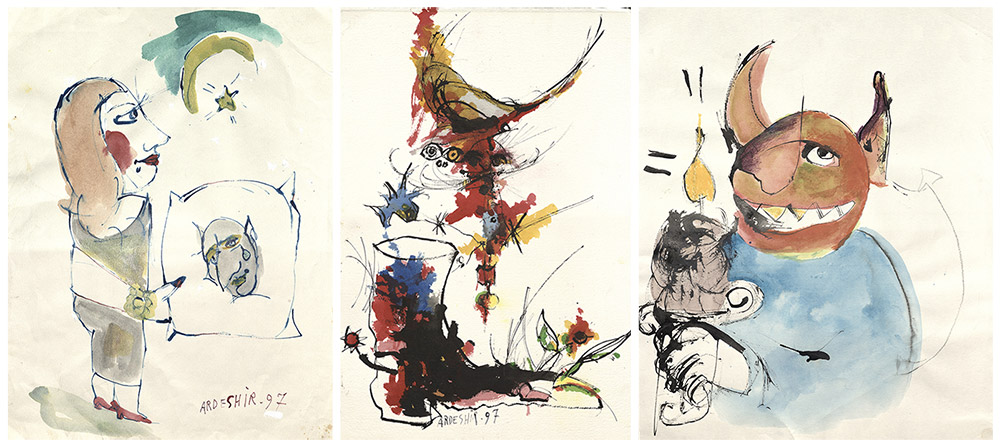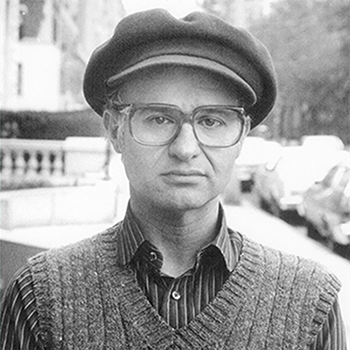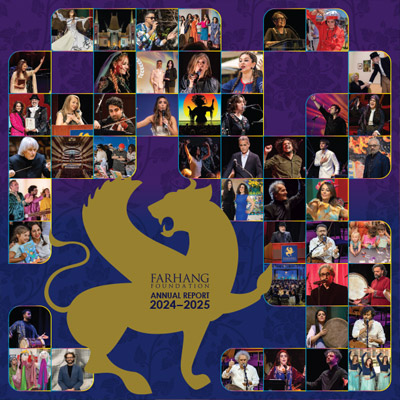Body Politics - Celebrating Ardeshir Mohassess’ Legacy

Farhang Foundation
and the
Ardeshir Mohassess Trust
Present
BODY POLITICS
Celebrating Ardeshir Mohassess’ Legacy in Art and Politics
AUGUST 6 - September 24

866 Camp St, New Orleans, LA 70130
In collaboration with
Talks & Virtual Programs - Coming Soon!
Body Politics is an exhibition of drawings created between 1985-1999 by Ardeshir Mohassess (1938-2008), one of the greatest political satirists of Iran. His diverse work spoke truth to power in times of turbulence and uncertainty. Famous for his sharp and courageous brush, Mohassess engaged his audience with a running commentary on the changing historical and political landscape, especially in his home country.
After graduating from Tehran University with a degree in political science in the 1960s, Mohassess worked as an illustrator for the Iranian press, eventually appearing in international publications as well. At the outbreak of the Iranian Revolution in 1979, Mohassess was on a temporary visit to the U.S., and he chose to remain in New York until his death in 2008. As chronicled by Dr. Bahman Maghsoudlou in the documentary “The Rebellious Artist,” although later in his life, Mohassess suffered from Parkinson’s disease, he still insisted on working every day. He lived with his drawings and paintings. They were his voice—and even though he is no longer with us, his images still speak loud and clear.
Curated by
SARA MADANDAR

ABOUT ARDESHIR MOHASSESS
Ardeshir (Ardešir Mohassess, born in Rasht, 18 Šahrivar 1317Š./ 9 September 1938; d. New York, 18 Mehr 1387 Š./ 9 October 2008) eminent cartoonist, illustrator, graphic satirist, and painter, who played a major role in the development of satirical cartoon in Iran.
The youngest of four children, Ardeshir was born to Abbās-Qoli, a judge, who died when Ardeshir was an infant, and Sorur Mahkāma Mohassess, an educator and poet. Ardeshir’s childhood coincided with the military occupation of Iran (1941-46) by the Allied Forces during World War II. At the age of three, after watching a film series called “Enemies of the Nazis,” he was asked to say something about the film. Instead of talking, he drew the scene he liked, and since then, in his own words, “it has been much easier for me to express my thoughts in my drawings than in any other form.”
Though Mohassess never studied art formally, majoring in political science instead, in 1951, he was encouraged by a classmate to submit his work to Towfiq, a leading satirical journal of the period. Over eight years, Ardeshir followed Towfiq’s style of illustration, creating pictorial commentaries on Iranian daily life and satiric editorials on political figures. Exaggeration of face and body was the essence of the magazine’s visual style. Later on, the publication of his drawings in Kayhān, a newspaper with mass daily circulation, introduced his unique visual language to a much larger audience and established his fame as a satirist with a unique personal style. His first solo exhibition, consisting primarily of pieces previously published in daily and weekly journals, was held at Qandriz Gallery in 1967. The exhibition attracted a large audience and earned him the praise of Karim Emami as “Iran’s most eminent caricaturist.”
In the late 60s and early 70s, Ardeshir was influenced by his Western contemporaries, such as the French illustrator Roland Topor (1938-1997), the British cartoonist Ronald Searle (1920-2011), the surrealist artist René Magritte (1898-1967), the American artist-cartoonist Saul Steinberg (1914-1999), and the American artist and illustrator best known for his caricatures, David Levine (1926-2009). Following their path, Ardeshir published eleven books of his drawings, created from 1971 to 1977, including Tašrifāt (Ceremonies, 1972) and Vaqāyeʿ-ye ettefāqiya (Current event, 1973).
In 1972 Ardeshir was invited to travel to Paris and collaborate for six months with Jeune Afrique, a weekly magazine founded in Tunisia and published in Paris, a trip that established him as an internationally acclaimed artist and which marked the introduction of color into his drawings: “Paris influenced me in that I discovered color. Color in Paris is incredible. One can see at least twenty different colors in a Parisian’s dress.”
Throughout these years Ardeshir’s standing as an artist soared. His drawings were featured in leading international graphic art magazines such as Graphis (Switzerland), Graphic Design (Japan), Idea (Japan), Graphic (West Germany), Opus International (Paris), and Communication Arts (USA). These drawings invited open interpretation and the shah’s regime did not appreciate the work’s connotations. Drawing upon his intimate knowledge of Iran’s culture, history, and sociopolitical situation, Mohassess created a series of political drawings, which attracted not only the attention of intellectuals, poets, and writers of the time, but also that of SAVAK, Iran’s intelligence and security organization.
In 1973 Ardeshir started to illustrate a number of articles for the Op Ed page of the New York Times, which continued to the end of his life. In 1974, at the opening of an exhibition of his works organized by Columbia University, Mohassess traveled to the US. for four months. He described the influence of New York City on his work: “In New York I feel I am part of a huge comic strip. This city’s influence brought to my work shapes, lines and geometric figures that appeared in my work for the first time.” In this collection—reminiscent of 19th-century Persian drawings—battle scenes, lovers’ stories, classical tales, religious stories, and myths all come together in the same drawing. Unlike his earlier drawings, which clearly aim at specific targets with a sure and steady pen, the satirical critique in this collection is more diffuse.
The compositional intricacy of these drawings illustrates a new phase in his artistic career. The depth of realism and craftsmanship are unmatched even by his earlier work. The drawings are simple outlines and are executed with a cool detachment. Some refer to and reflect on actual incidents that took place in the time leading to and during the 1979 Revolution—events such as the Rex Cinema fire in Abadan and the massacre that took place in Shiraz. The drawings, as noted by Mohassess, picture the Iranian culture and sociopolitical life through the eye of an artist-reporter. The individual pieces, however, are stylistically different from each other: some are heavily stroked, some are minimal in their treatment, and some are curvilinear drawings reminiscent of drawings by the famous 16th-century Persian miniature artist Reżā ʿAbbāsi (1565-1635). In 1986 Ardeshir was diagnosed with Parkinson’s disease, and due to the limitations caused by the disease, he embarked on a new style of drawing characterized by the abundance of abstract and colorful images and an explosion of assemblage. He put together different elements of his past drawings, newspaper cutouts, photocopies of various images, especially erotic photographs that were enhanced with watercolor to create a single cohesive image. He managed to maintain the urgency and vitality of his drawings. As his work became stylistically more fluid—the result of a combination of factors including his illness and a widening circle of influences—Ardeshir experimented with color, collage, and abstract elements. Yet his primal urge to satirize and critique always remained at the heart of his practice. Near the end of his life, his works became simpler and more direct.
Ardeshir Mohassess’s career spanned over half a century, a century with decisive turns in Iran’s socio-political environment. Throughout his career, Ardeshir had many solo and group exhibitions, starting with his participation in a group exhibition in the First Biennial Art Exhibition in Tehran (1958) and culminating in a major solo exhibition of his works at the Asia Society Museum in New York in May 2008. Despite his illness and its resultant physical limitations, he worked tirelessly. He was a sensitive, humble, and mild-mannered artist with a philosophic sense of humor that remained intact to the end. He seemed, as held by a critic and friend “so consumed by his work and oblivious to all that took place around him that one wondered how he could possibly manage the day-to-day chores of his life alone.” He did not marry and had no children. He died from a massive heart attack on October 9th, 2008 at his home in New York City, and was buried in Green-Wood Cemetery in Brooklyn.
SELECTED SOLO EXHIBITIONS
1967 Qandriz Gallery, Tehran
1969 Sayhoun Gallery, Tehran
1971 Municipal Club, Tehran
1971 Sayhoun Gallery, Tehran
1972 Iran-America Society Cultural Center, Tehran
1974 Columbia University, New York
1975 Graham Gallery, New York
1975 Litho Gallery, Tehran
1976 Zand Gallery, Tehran
1978 Zand Gallery, Tehran
1983 Studio 369, Boston
1986 Persian Arts Foundation, Los Angeles
1993 Westbeth Gallery, ‘Open Secret’, New York
2008 Asia Society Museum, Ardeshir Mohassess: Art and Satire in Iran, New York
SELECTED GROUP EXHIBITION
1958 First Biennial Art Exhibit, Tehran
1960 Second Biennial Art Exhibit, Tehran
1962 Third Biennial Art Exhibit, Tehran
1964 Fourth Biennial Art Exhibit, Tehran
1971 Musee des Arts, Paris
1973 Drawings from The New York Times, Musee des Beaux Arts, Bordeaux
1974 Drawings from The New York Times, Louvre Museum, Paris
1976 Modern Iranian Arts, Iran-America Society, Tehran
1976 The International Arts Fair, Basel
1977 Hayden Zand Gallery, Washington, D.C
1980 Politics and Arts: Ten Years of Graphic Commentary, 1970-1980, The American Institute of Graphic Arts, New York
PUBLISHED COLLECTIONS
Cāctus, a special issue of Daftarhā-ye zamāna on Ardešir
Mohassess, ed. Cyrus Ṭāhbāz, introduction by Karim Emāmi, Tehran, 1971.
Bā Ardešir o ʿarusakhāyaš (With Ardeshir and his puppets), introduction by ʿAli-Aṣḡar Ḥāj Sayyed-Javādi, Tehran, 1971.
Instances, ed. Kambiz Farrokhi, Haarlem, Netherlands, 1972.
Vaqāyeʿ-ye ettefāqiya (Current events), introd. Aḥmad Sāmlu, Tehran, 1973.
Šenās-nāma (Identity card), Tehran, 1973.
Tašrifāt (Ceremonies), introd. ydin ḡdāšlu, Tehran, 1973.
Ardešir o havā-ye ṭufāni (Ardeshir and stormy winds), introd. ʿAli-Aṣḡar Ḥāj Sayyed-Javādi, Tehran, 1973.
Kāfar-nāma (Hedonist’s notebook), Tehran, 1975.
Tabrikāt (Congratulations), Tehran, 1976.
Puppets, introd. Wendy Coyle, San Francisco, 1977.
Closed Circuit History, foreword by Ramsey Clark, introd. Ali Banuazizi, Washington D.C., 1989.
Life in Iran, Washington D.C., 1994.
Ardeshir Mohassess: Art and Satire in Iran, ed. Shirin Neshat and Nicky Nodjoumi, New York, 2008
END FAQ
Event Details
| Event Starts | 08/06/2022 |
| Event Ends | 09/24/2022 |
| Individual Price | Free |
| Location | SPILLMAN | BLACKWELL Fine Art |









